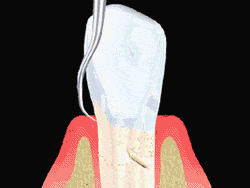Gum Disease Control
The importance of Oral Hygiene
Adults over the age of 35 are more likely to lose teeth due to gum disease (periodontal disease) than cavities. Three out of every four adults will be affected at some point in their lives. The greatest strategy to avoid cavities and periodontal disease is to practice effective tooth brushing and flossing practices on a daily basis.
Bacterial plaque causes both periodontal disease and decay. Plaque is a white coating that adheres to the gum line of your teeth. Plaque builds up on your teeth all the time. You may remove these germs and help prevent periodontal disease by brushing and flossing your teeth thoroughly every day.
Periodontal disorders can be accelerated by a variety of circumstances. However, it is primarily caused by bacteria present in dental plaque, a sticky white film that accumulates on your teeth on a regular basis. Plaque hardens into a tough, porous substance known as calculus if it is not removed properly with frequent brushing and flossing (or tartar).

OTHER IMPORTANT FACTORS AFFECTING THE HEALTH OF YOUR GUMS INCLUDE:
- Smoking
- Diabetes
- Stress
- Clenching and grinding teeth
- Medication
- Poor nutrition
Preventing Gum Disease
Periodontal Disease
Plaque bacteria create toxins or poisons that irritate the gums, causing them to turn red, swell, and bleed readily. If the irritation continues, the gums separate from the teeth, resulting in the formation of pockets (spaces). Periodontal disorders degrade the supporting gum tissue and bone that hold teeth in place. If left untreated, this will result in tooth loss.
Preventing Gum Disease
Effective daily brushing and flossing, as well as frequent professional inspections and cleanings, are the most effective ways to avoid gum disease. Unfortunately, even with the most meticulous at-home dental care, people might develop periodontal disease.
Preventitive Cleaning
The first stage of periodontal disease treatment is usually a thorough cleaning, which may include scaling or root planing. The goal of these non-surgical techniques is to remove etiologic agents that promote gingival inflammation and disease, such as tooth plaque and tartar, or calculus. Scaling and root planing can be performed as an individual therapy or as a prophylactic precaution. They are frequently used to treat gingivitis and mild to severe periodontal disease.
What does Preventitive Cleaning entail?

Scaling
Scaling removes calculus and plaque that has adhered to the tooth surfaces. The procedure focuses on the area beneath the gum line, along the root. Scaling is done with an ultrasonic scaling tool, which is a type of dental tool. The scaling instrument typically comprises an irrigation technique that can be used to introduce an antibiotic substance beneath the gums to aid in the reduction of oral germs.

Root Planing
Root planing is performed in order to remove cementum and surface dentin that is embedded with unwanted microorganisms, toxins and tartar. The root of the tooth is literally smoothed, which promotes healing, and also helps prevent bacteria from easily colonizing in the future.
